Easy Bok Choy Kimchi
Bok choy kimchi is crisp, refreshing, and quick to make. Fresh chilies, garlic, and classic kimchi seasonings coat the tender greens for a light, flavorful side dish. Enjoy it right away for a clean, bright taste or let it ferment slightly for a tangy kick.
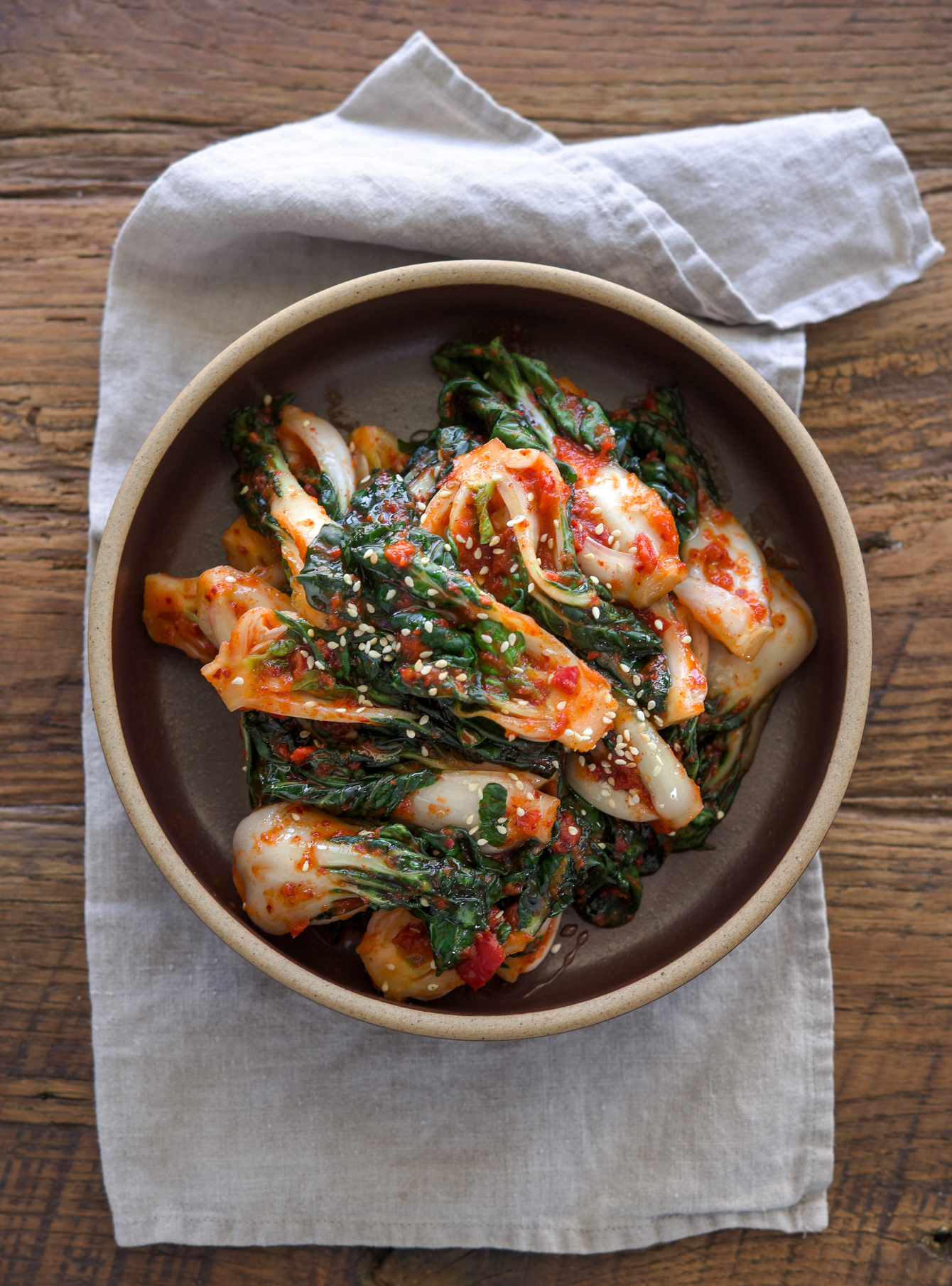
I first came up with this bok choy kimchi recipe when I lived in Hong Kong, where I often shopped at the street markets.
The baby bok choy was always so fresh, beautiful, and inexpensive that I started making kimchi with it instead of napa cabbage—and it turned out to be a big success.
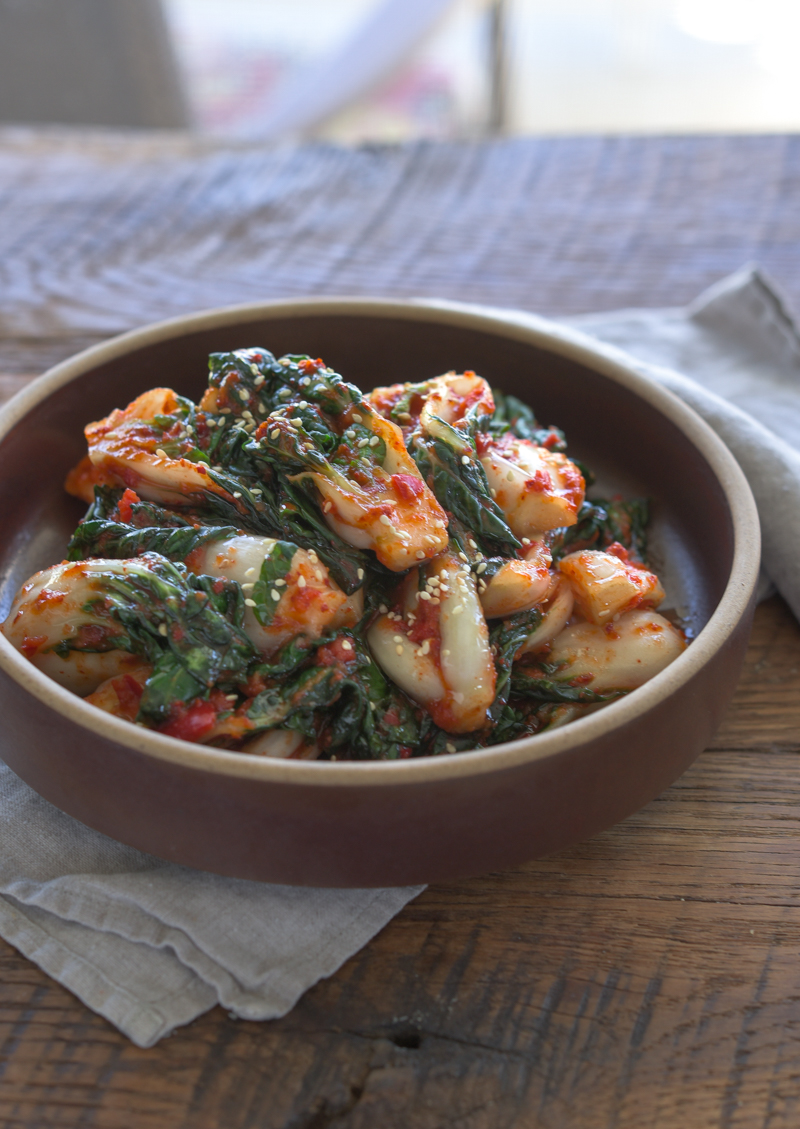
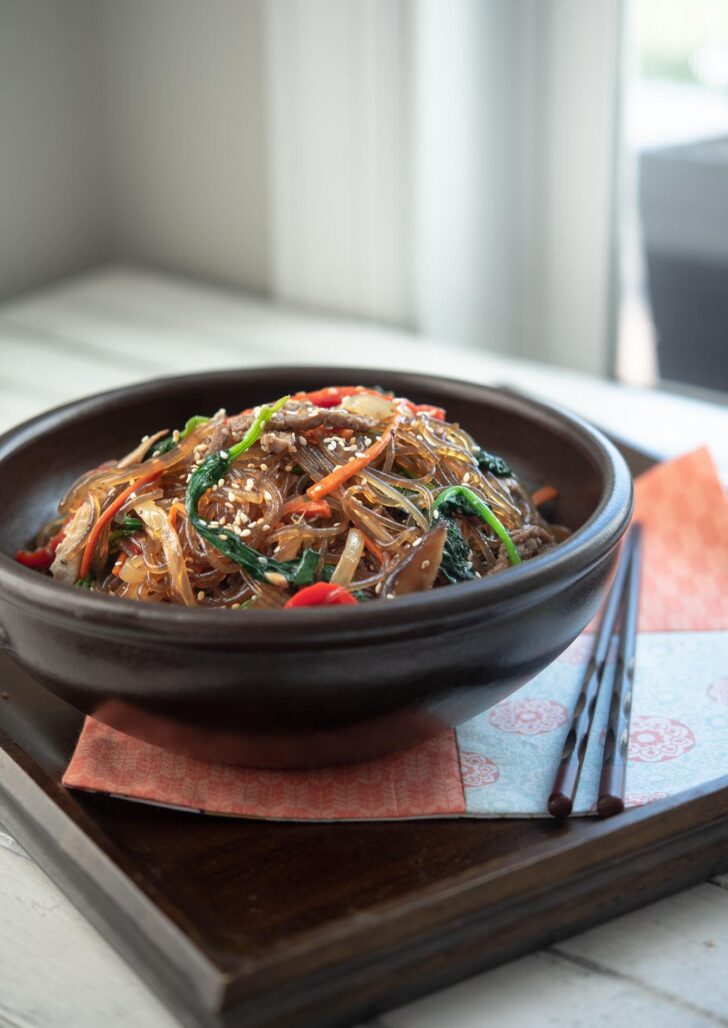
Get new recipes via email:
The process is similar to quick napa kimchi, but I add chopped fresh red chili to brighten the flavor and complement the delicate crunch of bok choy. It’s a refreshing twist on Korean kimchi that doesn’t require long fermentation—great as a fresh side dish or enjoyed slightly tangy after a day or two.
I used to share it with friends and neighbors, and it always got rave reviews. Everyone wanted the recipe! If you’ve never tried making kimchi with bok choy before, this easy method is a great place to start.
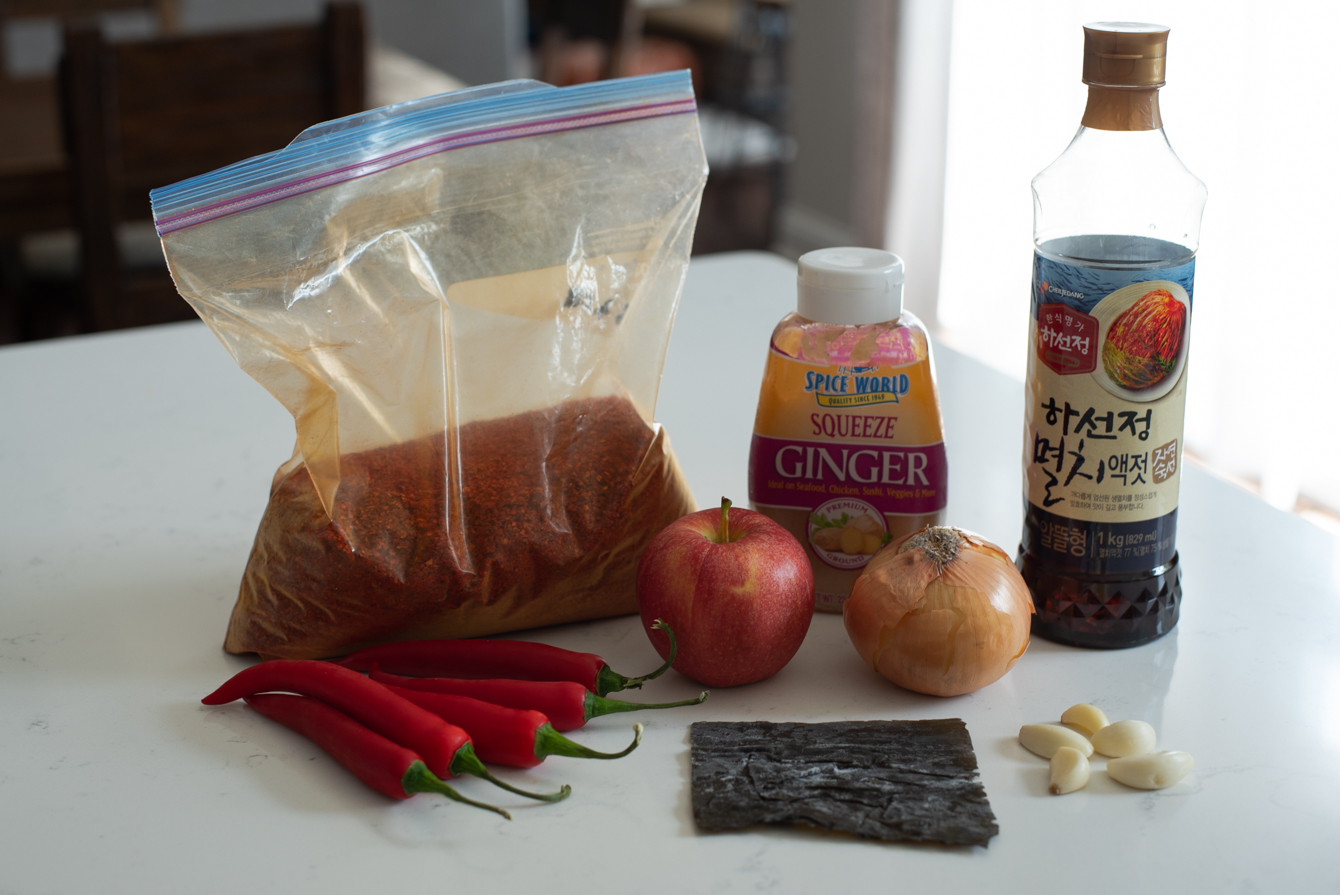
My Go-To Ingredients for Fresh Bok Choy Kimchi
- Bok Choy: I prefer using baby bok choy for its tender, crisp texture, but Shanghai bok choy works just as well. It stays beautifully crunchy even after a quick brine, which makes it ideal for fresh kimchi like this. Be sure to rinse thoroughly—dirt loves to hide between the stems.
- Korean Sea Salt: A brief soak with coarse Korean salt draws moisture from the stems and gives the bok choy just enough bend to hold the kimchi paste without becoming limp.
- Kimchi Paste Ingredients: I use sweet apple instead of sugar to round out the heat—it keeps the flavor clean and naturally balanced. Gochugaru adds warmth and color, while fish sauce, garlic, and ginger bring that deep, classic kimchi flavor. This mix keeps it bold but still light, perfect for bok choy.
- Fresh Red Chilies: This is where I add a personal touch. When I first developed this recipe in Hong Kong, I started using chopped red chilies to brighten the bok choy flavor. Fingerlong chilies are perfect—mild and refreshing. If you can’t find them, just use extra gochugaru.
- Optional Kelp Stock: I often simmer a small piece of dried kelp for a few minutes to use as the liquid in the kimchi paste. It’s subtle, but adds a layer of umami that I really love.
How I Make Bok Choy Kimchi (Step-by-Step Visual Guide)
These step-by-step photos are here to guide you visually through the recipe. For exact measurements and full instructions, scroll down to the printable recipe card below.
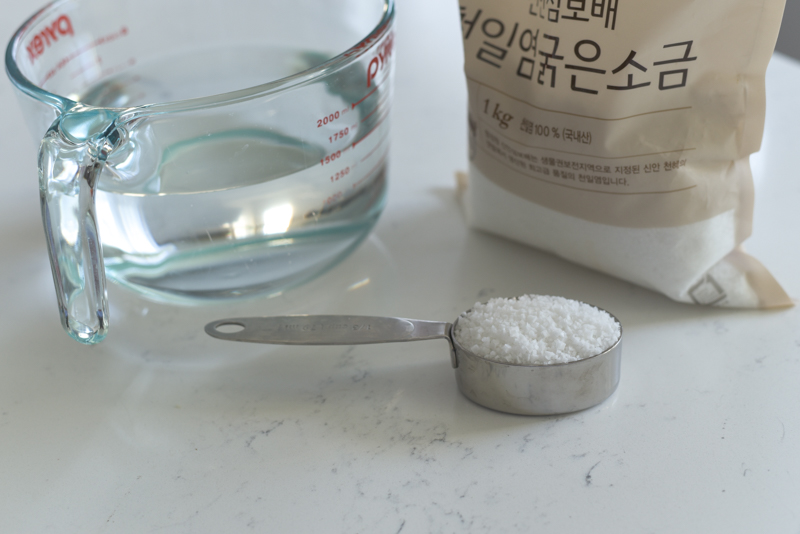
First, you will need to mix salt with water.
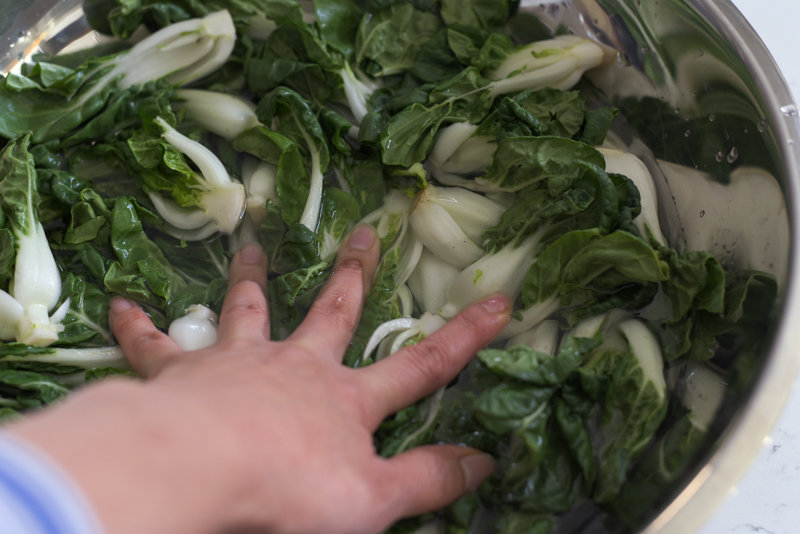
Soak the bok choy in salt water just long enough to soften the stems—30 minutes does the trick.
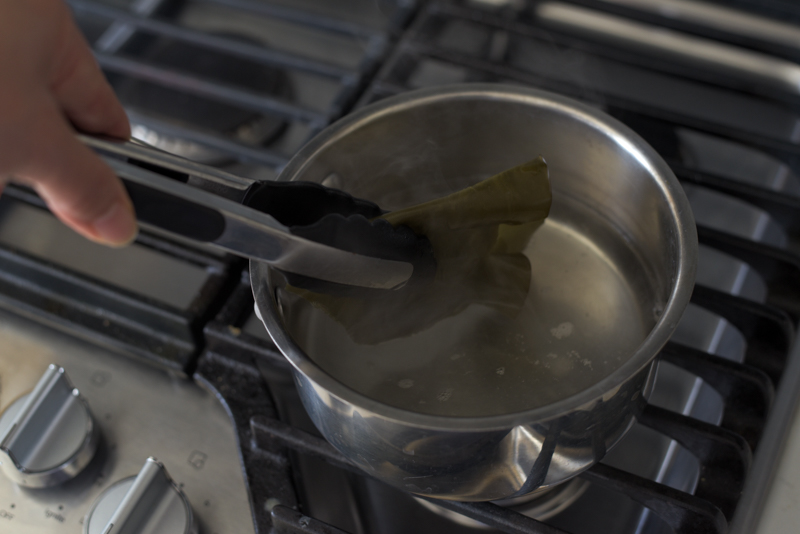
Optional Kelp Stock: Simmer a small piece of dried kelp in water for a few minutes and let it cool before using.
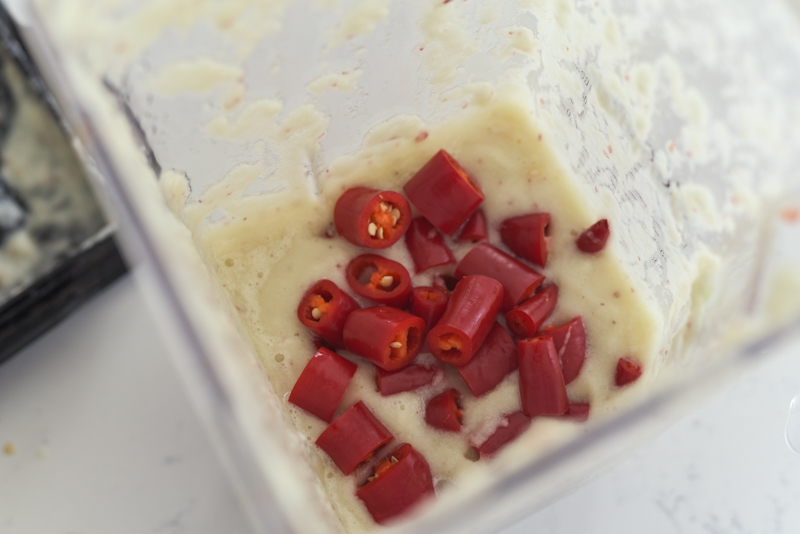
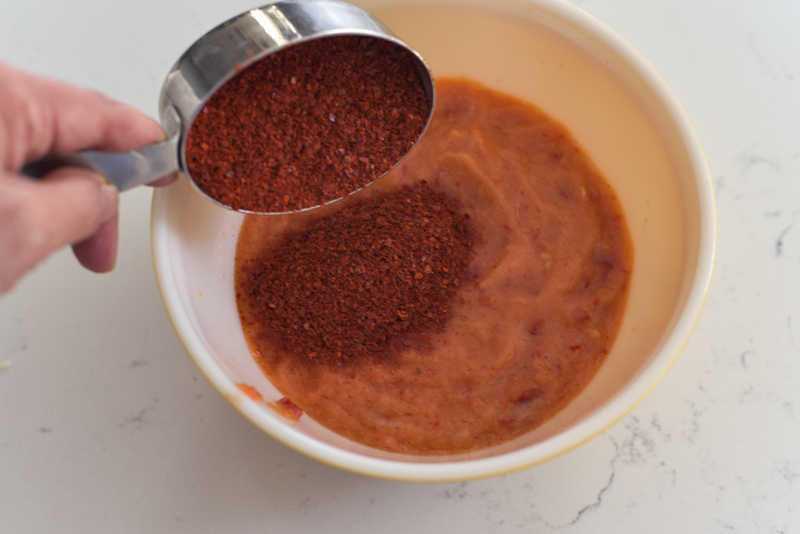
Make the kimchi paste using a blend of onion, apple, garlic, and mild fresh chilies.
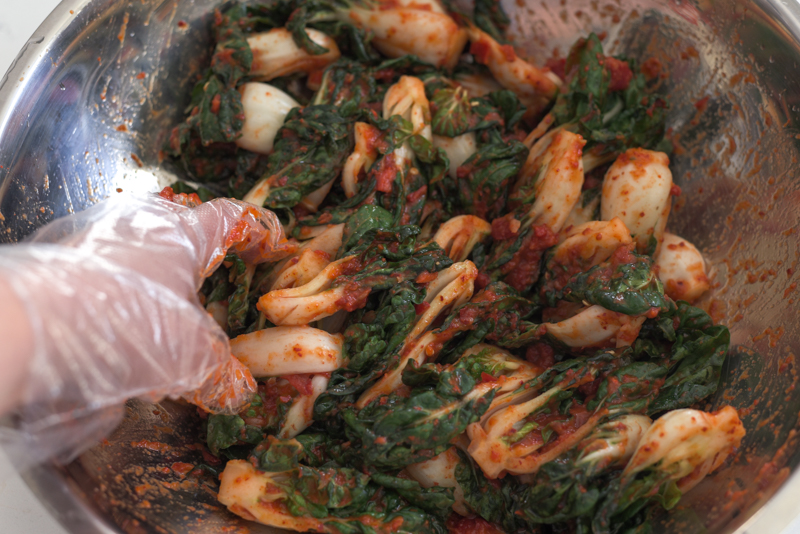
Toss and coat the bok choy gently so the leaves stay intact. You don’t need much paste—just enough to season every piece. Enjoy this kimchi as a salad or a side dish. It pairs particularly well with bulgogi or LA galbi.
Want to make bok choy kimchi without fish sauce? Try Korean soup soy sauce for a delicious vegetarian alternative with rich flavor—just like in my vegan kimchi recipe!
Fermentation Tips
I usually enjoy bok choy kimchi fresh—it’s crisp, light, and perfect as a quick side. But if you prefer a bit of tang, just leave it out at room temperature for a day to kickstart fermentation, then move it to the fridge.
Unlike napa cabbage kimchi, this version ferments fast and isn’t meant for long storage. In my experience, it tastes best within 2 weeks—after that, the bok choy starts to lose its texture.
For more variety of Korean kimchi ideas, check out my kimchi recipe collection to get insperations.
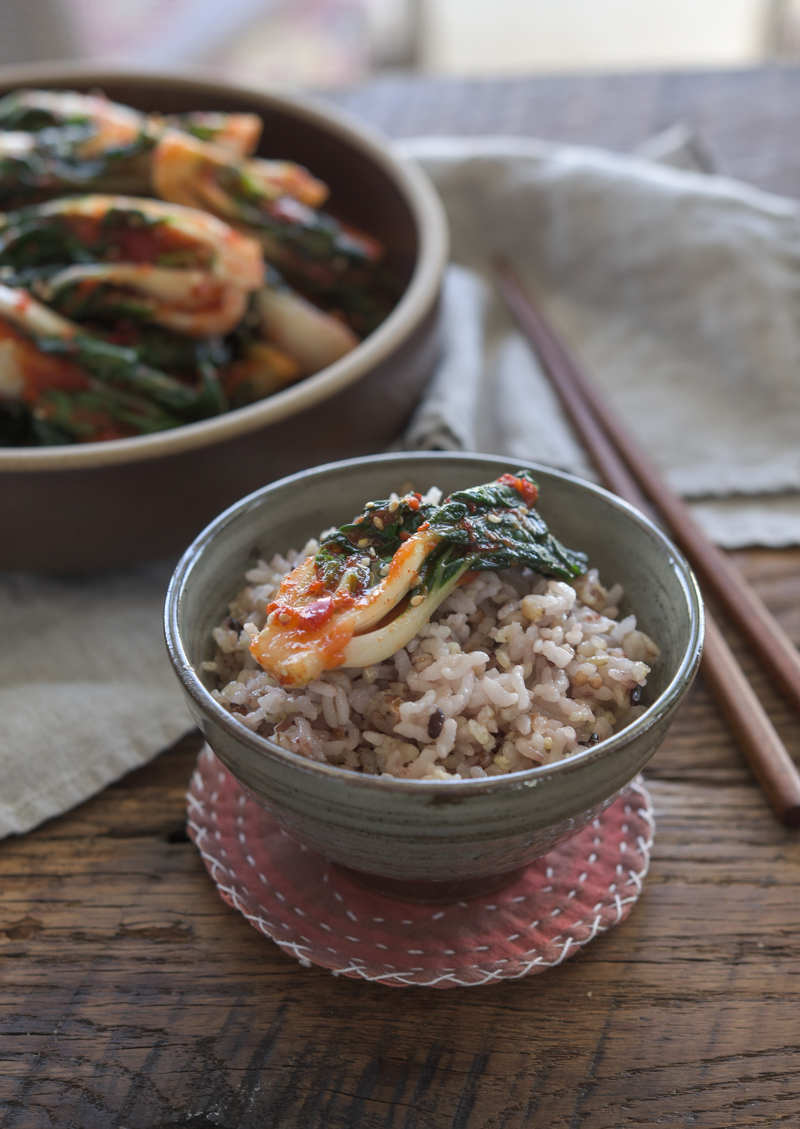
Love this recipe? Rate it and share your experience in the comments below! On Instagram? Tag me to showcase your creation. For more delicious recipes, subscribe to our newsletter!
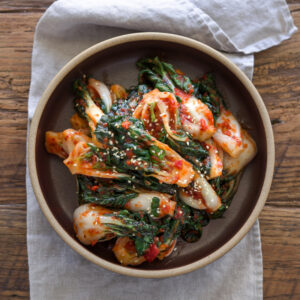
Easy Bok Choy Kimchi
Ingredients
- 1 1/2 lb (680 g) bok choy, halved or quartered lengthwise
- 6 cup (1.4 liters) water
- 1/3 cup (55 g) Korean coarse sea salt
For kimchi seasoning
- 1/2 (about 100 g) large onion, diced
- 1 (about 180 g) sweet apple, seeded and diced
- 5 cloves garlic
- 4 tbsp (60 ml) Korean anchovy sauce
- 1/4 cup (60 ml) sea kelp stock , or water (see notes below)
- 5 (30 g) fresh red fingerlong chilis, diced
- 1/3 cup (30 g) Korean chili flakes (gochugaru)
- 1 tbsp (15 g) ginger paste
Instructions
- Place clean bok choy in a large mixing bowl. Dissolve the sea salt in water and pour over to bok choy. Let it sit for 30 minutes, then drain.
- To make the kimchi seasoning, puree onion, apple, and garlic with 1/4 cup of sea kelp stock in a blender until smooth. Add the sliced red chilies and pulse the mixture until the chilies are processed into small pieces.
- Put the pureed mixture into a medium mixing bowl. Add the Korean chili flakes, anchovy sauce, and ginger puree. Mix well.
- Toss the bok choy with the kimchi seasoning paste. Be gentle when you are coating the bok choy with the paste so that you don't bruise them.
- Bok choy kimchi tastes best within 2-3 days, as it is not meant for long-term storage like most Korean kimchi. If there's any leftover, store it in an airtight container in the refrigerator. If you prefer it fermented, leave it at room temperature for one day before refrigerating. I recommend consuming this kimchi within 2 weeks if fermented.


I remember this recipe using banana instead of sweet apple, what changed? I was going to make it again but noticed that was missing!
Yes, I originally used bananas in the recipe—it’s surprising you remember that from 10 years ago! The original version with bananas was fine, but I’ve grown to favor apples paired with bok choy. The banana’s aroma does get stronger as the kimchi ferments, which I didn’t mind, but it might not appeal to everyone.
Holy cow! Just packed it into the jar and am concerned it is so hot it will remove paint. Used half of the peppers and chili and gave it a little taste. Whoa! Will it mellow out the longer its fermenting?
Hi Krista
The spiciness will mellow down as kimchi ferments. However, if your chili pepper itself is extremely spicy one, it will still be spicy but a little less.
I am going to try your recipe as written the next time. This time I made some major changes. I added Daikon radish, carrots and spring onions. I had 40 baby Bok Choy to make this recipe.
I had just made Napa cabbage kimchi (15 heads of cabbage) and had a lot of the stuff left over, so I used it.
Hi Gayle
15 heads of cabbage make a lot of kimchi. Using the leftover kimchi paste in this recipe works. Hope you enjoy it.
How come bokchoy kimchi doesn’t work well for longer fermentation? What happens?
Bok choy is tender cabbage and has a slight grassy taste to it. Long fermentation makes the bok choy a little bitter and not as pleasant. It’s great to enjoy as a freshly made kimchi and sligthly fermented kimchi.
I love bok choy! This version of kimchi might be one my hubby will like! Will have to give it a try 🙂
I adore bokchoy, but have never tried one with kimchi..looks so appetizing!
I make napa cabbage kimchi quite frequently & this bok choy kimchi sounds great. Exactly what red pepper should I use & what is a good substitute?
Hi Robert
You can use fingerlong red chili peppers. They look like finger sized chilies and many Korean and Asian stores sell them. They are mildly spicy. I used 5 in the recipe, but you can use less if you don’t want it to be too spicy. If you can’t find the fingerlong chilies, you can omit them, and add 2 tbsp of Korean chili flakes.
Hope this helps.
Hi Holly, please recommend – I have anchovy in a can (how much do I use) and I have shrimp paste on which it written that it needs to be cooked can not be consumed raw? Any suggestions how to do it & how much please & I will be on my way making it
Hi Helen
I am not sure what anchovy in a can like. Is it covered in oil? Is so, it is not suitable to make kimchi with. Anchovy sauce in kimchi is from fermented anchovies. Is your shrimp paste is like a block of hard past or actual baby shrimps (either whole or chopped) in salted brine? If it is raw, in most cases you need to cook to consume. But for kimchi making, you can add as raw since it goes to ferment.
Fro this recipe, you will need only 1 tablespoon if you use with anchovy sauce. However, if your anchovy sauce is not applicable, you cam make-up with shrimp sauce. Just add the same amount that the recipe is asking for the anchovy sauce.
Please feel free to ask if you need more help.
Can the shrimp and anchovy sauce be replaced with just fish sauce?
Yes, but adjust the amount but reducing slightly. Taste and season more if needed.
This looks delicious~ I can’t wait to make it.
I was wondering is there a substitute for the salted shrimp if I cannot find any in my area? Such as fish sauce?
Yes, you can substitute with fish sauce. Thanks Ayame!
Plz don’t tell me you live in Malaysia…
But if you do plz tell me where you buy your ingredients(Korean salt,Korean chilli flakes ,Korean anchovy sauce and Korean shrimp sauce and of course Korean radish)
I can’t find them anywhere…
There are several Korean groceries in Ampang and Mont Kiara areas. Hope you get to find them.
Thanx for the help^^
I packed into Mason jars and now immediately regret it. I think it’s going to me mush when I eat it next week. Should have put it in a zip lock bag or box.
I had to cut all my purple lady bok choi this morning before it could bolt, had probably 40 plants all at once in the garden. I usually eat it sautéed with garlic but after packaging two nights worth for that I needed to do something different.
I added some rose vinegar and toasted sesame seeds and hungarian paprika to my paste. I couldn’t find the right pepper flakes and grabbed a kim chi seasoning mix that had it and other spices and salt so that’s where the idea of adding paprika came from… didn’t want to use to much of the mix with salt. Came out really great. Just worried about them being in jars now. Maybe I’ll go pull them out and put in something else.
Hi April
Storing kimchi in a mason jar is a preferred method as it effectively keeps the air out, so I wouldn’t worry about that.
However, it’s not recommended to add vinegar when making kimchi, especially if it’s fragrant. Using paprika is fine in this recipe since it reduces the spiciness of the seasoning. As for Bok choy kimchi, due to the tenderness of the vegetable, it’s not ideal for long-term fermentation. Therefore, I recommend consuming it within 2-3 weeks after preparation. I hope you find this information helpful. Thank you!
Thanks to my father who stated to me concerning this blog, this weblog is actually
amazing.
i taste it kimchi and banana! it is really incredible! thanks for sharing. best regards from hamburg
Why don’t we not fritter away an excessive amount of time with the specifics. It’s obvious
you’re coming up with a excellent point here.
After looking into a handful of the articles on your blog, I
seriously appreciate your technique of writing a blog. I book-marked it to my bookmark site list and will be checking back in the
near future. Please check out my website as well and let me know what you think.
I came across your blog just to find about kimchi and i found this awesome recipe!
For your information, I’m from Malaysia and yes, we do have lots of banana here.
I normally love eating raw banana and sometime i use it in my cakes and etc.
Maybe I can try this recipe! Thanks alot for this great great recipe!
Hi there…I am an Indian, just happened to be surfing blogs and came across yours. I must tell you, reading about all the delicious kimchi has made my belly growl..so i’ll have to run to the kitchen now..although m sure m not going to find kimchi there.. 🙂
In between two kinds of kimchi I kept thinking, why not try this at home in India…It sounds interesting but plain challenge due to availability of the ingredients. I am not going to give up on this idea…
will let you know about the Indianised version of this.. thanks for the beautiful post
Hi Akki
I would love to hear about you adventure of cooking Korean food, especially with ingredients available in India. Please, Keep me posted.
This is genius! 🙂
I will have to try this myself soon. I am wondering though, you said the kimchi tastes best fresh, but have you observed anything unusual after it has fermented in regards to looks/taste/shelf life? I like using the natural sweetness of fresh fruit in my kimchi instead of adding sugar and sticky rice glue/sauce/paste (eek, such an awkward name for it!) is a must for me when I make kimchi, so this would be a perfect alternative.. But, I have noticed that some fruits don’t work as well (persimmons, for example, seem to affect the looks negatively), so I’m just wondering how well banana ferments.
Hi Julia, banana would be great alternative for sugar in kimchi making. However, if you prefer the ideally fermented flavor of kimchi, it is better to use rice glue (or use ordinary rice blended with water). I didn’t taste any strong banana flavor in my freshly made Bok-choy kimchi, which tasted really great for the first a few days, but once strongly fermented (after about a week), I am not sure if Bok-choy is the right choice for the ferment flavor. It is hard to say that is because of banana or bok-choy itself. I am going to try banana with nappa cabbage to see how the fermentation is like. If you ask me, Bok-choy is such a tender cabbage and it is better to finish while they retain their fresh flavor and the texture with a hint of fermentation, but not overly like nappa.
I see, thank you for the quick reply! I don’t usually have bok choy at home, but I will give the banana thing a try with some napa next time. 🙂
Banana was a real surprise! The last shot with rice and kimchi. Aw, that’s a great photo!!
I had never thought of using bananas in the paste but we tried it and oh yeah, that is good!
We only loosely followed the recipe because for us kimchi is about preserving what is coming out of the garden, not what is on a recipe card. That being said, the banana flavor is now a favorite. Thank you!
It’s a colourful food
This looks delicious. YUM!
When I first read the title of this post, I thought eurgh, no way!
Now I feel an urge to try this out for myself! Thanks Holly!
Lucy, I hope you to try this Bok Choy kimchi. It tastes quite nice and you don’t taste much of banana flavor at all.
Wow, how interesting! I never even heard of bok choy kimchi and using a banana?! I can’t wait to try this, it looks delicious! My husband is Korean, I hope he will like it…
Hi Caroline, I hope your husband will like it. Serve with Doenjang Jjigae (soybean paste stew), if he likes Jjigae, that would be quite traditional meal.
hi holly!
i’ve been a silence reader to your blog for quite a while. i love korean food (thanks to korean drama) and i’ve been following how you make those kimchi. i’m from malaysia and i’m so so happy to have this “malaysian” version of kimchi. i will try it and i’ll let you know how it turns out .. 😀
have a good day!
Hi Sue
Thanks for the comments. I would love to hear how it turns out. Hope you like it.
I’ve never heard of Banana Kimchi! And what’s great about this is it’s ready to eat right away – good for impatient sorts like me. Terrific recipe – really eye opening. Thanks.
Love this! How unique, simple and just plain genius! We’re going to feature this on our Facebook page and link here so people can see how you did it, and your lovely photography. If you wish, come LIKE us on Facebook for more recipes and tips on Asian green vegetables like baby bok choy, gai lan (Chinese broccoli), dau miu (pea shoots), yu choy, etc.
That kimchi looks good and I like the sound of using a sweet banana in it! I will have to try using a banana in my next batch of kimchi!
Thanks Kevin. Hope you can give it a try.
wow, what a neat idea to use banana! i would never have thought of that…i’m so curious to try it out! 🙂
Bananas? Ingenious! Have yet to try bok choy kimchi but it looks good.
Give it a try, Swan. It is quite easy to make and it tastes best when freshly made. Very crunch yet soft.
What an interesting addition! Inspiration can come from anywhere. I would be very curious to taste this kimchi. 🙂
You are right. I just get so impressed with people with creative minds in foods. You are one of them!
Holly, this sounds really unbelievable! I will definitely try it next time. Thanks for sharing and good luck with the new blog!
Best wishes from germany,
Tina
Hi Tina, this kimchi tastes refreshingly good. I loved it. Hope you are doing well.